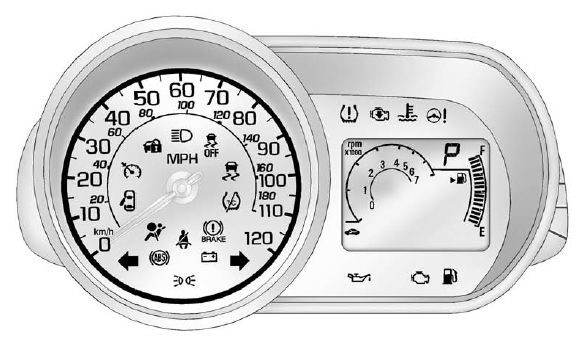Chevrolet Spark Owners Manual: Warning Lights, Gauges, and Indicators
Warning lights and gauges can signal that something is wrong before it becomes serious enough to cause an expensive repair or replacement. Paying attention to the warning lights and gauges could prevent injury.
Warning lights come on when there could be a problem with a vehicle function. Some warning lights come on briefly when the engine is started to indicate they are working.
Gauges can indicate when there could be a problem with a vehicle function. Often gauges and warning lights work together to indicate a problem with the vehicle.
When one of the warning lights comes on and stays on while driving, or when one of the gauges shows there may be a problem, check the section that explains what to do. Waiting to do repairs can be costly and even dangerous.
Instrument Cluster

English Automatic Transmission Shown, Metric and Manual Transmission Similar
- Speedometer
- Trip Odometer
- Tachometer
- Fuel Gauge
- Safety Belt Reminders
- Airbag Readiness Light
- Passenger Airbag Status Indicator
- Charging System Light
- Malfunction Indicator Lamp
- Service Vehicle Soon Light
- Brake System Warning Light
- Antilock Brake System (ABS) Warning Light
- Up-Shift Light
- Power Steering Warning Light
- Traction Off Light
- StabiliTrak® OFF Light
- Traction Control System (TCS)/StabiliTrak Light
- Engine Coolant Temperature Warning Light
- Tire Pressure Light
- Engine Oil Pressure Light
- Low Fuel Warning Light
- Immobilizer Light
- Reduced Engine Power Light
- High-Beam On Light
- Front Fog Lamp Light
- Cruise Control Light
 Power Outlets
Power Outlets
The accessory power outlets can be used to plug in electrical equipment, such
as a cell phone or MP3 player.
The vehicle has an accessory power outlet in front of the cupholders on the center
sta ...
 Speedometer
Speedometer
The speedometer shows the vehicle speed in kilometers per hour (km/h) and miles
per hour (mph).
Odometer
The odometer shows how far the vehicle
has been driven, in either kilometers or miles. ...
Other materials:
Radio Frequency Statement
This vehicle has systems that operate on a radio frequency that complies with
Part 15/Part 18 of the Federal Communications Commission (FCC) rules and with Industry
Canada Standards RSS-GEN/210/220/310, ICES-001.
Operation is subject to the following two conditions:
The device may not cause ...
Tire Terminology and Definitions
Air Pressure: The amount of air inside the tire pressing outward on each square
inch of the tire. Air pressure is expressed in kPa (kilopascal) or psi (pounds per
square inch).
Accessory Weight: The combined weight of optional accessories. Some examples
of optional accessories are automatic t ...
High/Low-Beam Headlamp
Connector Retaining Tab
Connector Release
Headlamp Bulb
To replace a headlamp bulb:
Open the hood. See Hood on page 10-5.
Remove the connector retaining tab (1).
Disconnect the wiring harness connector from the bulb (3) by pressing the
connector release (2) and pulling strai ...
